wrestling / Columns
The Magnificent Seven: The Top 7 Ric Flair Rivals
When you talk about long professional wrestling careers, filled with incredible performances and accomplishments, you’d be hard pressed to find a figure more worthy of discussion than Ric Flair. This week, I’m taking a look back at The Nature Boy’s seven best rivalries.
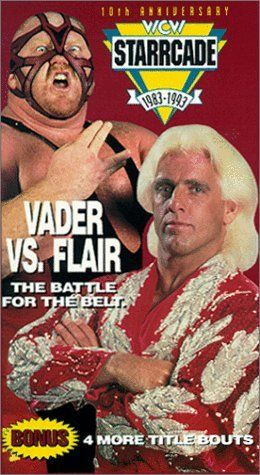
#7. Big Van Vader
Ric Flair’s matches with Big Van Vader are generally well-received, but tend to get dismissed for a number of reasons. Flair was a face, and he did his best work as a heel. While Flair didn’t yet show his age in an overwhelming way at this point in his career, he was a shave past his physical prime . And while their matches (particularly the main events of Starrcade 1993 and Super Brawl 1994) were very good, they don’t necessarily rate among Flair’s all-time best.
I won’t flat-out deny any of those aforementioned limitations, but I will make the argument that the Vader feud is underrated for its subtext of generational clashes. In Flair, you have the NWA and WCW’s prototypical world champ—a guy with top-tier technical ability, great mic skills, endurance, and an uncanny ability to portray the chickenshit heel. And then you have Vader—one of very few talents to that point trusted as a prolonged world champion monster–a forefather to Brock Lesnar’s current run, and, I would contend, Yokozuna’s run atop the WWF that started the better part of a year after Vader started rolling in Atlanta. If you need further support for studying this match as a generational clash, consider, too, Vader’s manager at the time—Harley Race, the more rough and tumble heel world champ who had passed the torch to Flair a decade earlier.
Historical perspective aside, this was a rare feud in which Flair played an aging and outsized underdog, seeking to overcome insurmountable odds against an insanely fast and hard-hitting super heavyweight. It’s a classic story and arguably WCW’s last great feud before the lackluster face Hogan era, which gave way to Hogan himself playing the chickenshit heel, fronting the NWO. But speaking of Hogan…
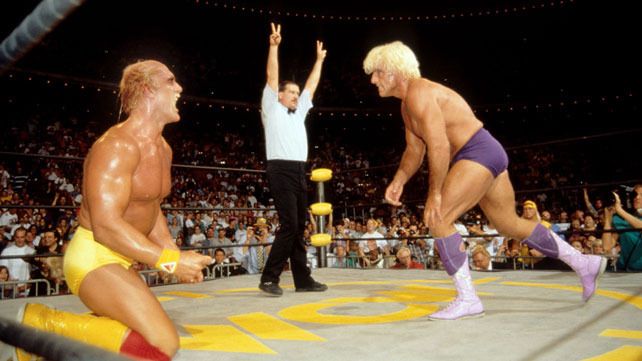
#6. Hulk Hogan
Flair built his legacy, first and foremost, on classic matches, and I’ll be the first to admit that his in-ring confrontations with Hulk Hogan didn’t do a ton to further the Flair story. That said, Ric Flair vs. Hulk Hogan was a certified dream match throughout the 1980s and early 1990s—the face of the NWA/WCW vs. the face of the WWF, and the men always seemed to always end up on opposite sides of the face, heel spectrum, which made them natural rivals.
The WWF got the first crack at this feud when Flair signed with the company in 1991. And though they danced around the program with Flair putting himself over as the real world champion, backed by classic Hogan nemesis Bobby Heenan, the match up never really materialized in a meaningful way based on a combination of reasons including the pairing allegedly drawing poorly on the house circuit, and the timing of Hogan deciding to “retire” at WrestleMania 8. Just the same, the WWF did lay the foundation for a Hogan-Flair program, and if anything made fans salivate all the more for the two of them eventually clashing.
So, the table was set when Hogan debuted in WCW in 1994, and the company didn’t waste a second in pushing Hogan as the challenger to Flair’s world championship at that year’s Bash at the Beach. The build was quite good and the match was solid, if unspectacular. Perhaps most importantly, WCW sold it as the paradigm shift it was—Hogan was the company’s new star and Flair was old news.
Unfortunately, that iteration of the Hogan-Flair feud would run too long with a series of rematches that Hogan dominated, leading up to a steel cage match with Flair’s career on the line at Halloween Havoc. For better or worse, Flair would return from his faux retirement within half a year, when Vader refused to job repeatedly to Hogan, and Flair essentially did so for him, nonsensically inserting himself into a strap match for the sake of the being the fall guy and reigniting his own program with Hogan—a period that, if nothing else, showcased Flair’s willingness to put over others.
The Hogan-Flair story would take another turn when Hogan turned heel and Flair became his face challenger for a stint—an alignment that may seem off kilter but that, given the allegiances of WCW’s loyal fanbase, actually made a lot of sense and helped solidify Hogan as the top villain of the day. That program would continue on and off, including Flair reuniting the Horesemen to challenge the NWO.
The Hogan-Flair program would continue long after WCW went out of business in 2001, albeit on smaller stages. Hogan recruited Flair as his opponent for a series of matches on his 2009 tour of Australia. The twosome would square off one more time in 2010, with Hogan backing Abyss and Flair seconding AJ Styles for a program that culminated in a tag match between the two factions.
So, though it never reached the peaks die hard fans might have hoped for, Flair’s ongoing rivalry with Hulk Hogan earns its spot on the countdown for the level of interest it generated in the fans, longevity, and achieving success across a striking range of contexts and settings.

#5. Harley Race
Ric Flair is so well-established as a veteran that it’s hard to think about a program in which he was the young up and comer, daring to challenge the veteran. Race ended Flair’s very first world title reign in 1983, and proceeded to offer a $25,000 bounty to anyone who would take out the young upstart, thus setting up their program for the biggest show of that year—Starrcade. Before a live audience in Greensboro, North Carolina, Race formally passed the torch to the NWA’s next great champion.
Flair beating Race was not altogether unlike Hulk Hogan besting The Iron Sheik, Steve Austin pinning Shawn Michaels, or John Cena taking the strap off of JBL. It was the win on a major stage that took a budding star on the cusp and made him bona fide main event superstar with a meaningful place in wrestling history. Better yet, the two would reprise their rivalry a decade later, when Race managed world champ Big Van Vader, only for Flair to topple that champ, too.
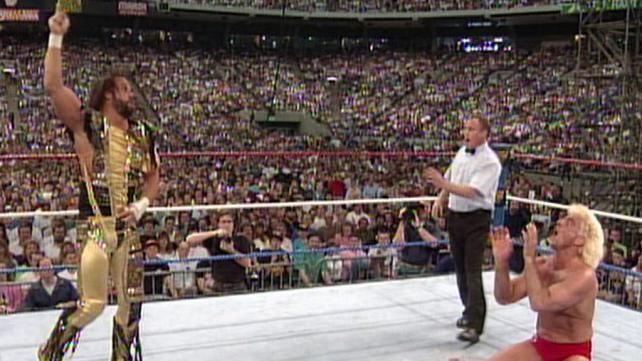
#4. Randy Savage
A big part of why Ric Flair is considered one of the greatest wrestlers of all time is that he combined tremendous in-ring performance with artful promo work. When it comes to that combination of skills, one of the few wrestlers of the same generation to match Flair was Randy Savage. In 1992, while everyone was waiting for Hulk Hogan versus Ric Flair, Savage swooped in became the challenger for Flair’s WWF Championship at WrestleMania 8. The result was a brilliantly heated feud. I dare say no wrestler has ever demonstrated more fire more consistently than Savage defending the honor of Miss Elizabeth. The feud resulted in a sensational one-on-one encounter that far exceeded any of the Hogan-Flair matches before or after. While it tends to get forgotten, the program would continue past that point, with Flair inserting himself into the Savage-Ultimate Warrior SummerSlam feud, taking back the title on TV in the fall (Flair serving as the transitional champ to get the strap onto Bret Hart), and then teaming opposite him in a headlinging tag match at Survivor Series.
Savage and Flair shored up their program’s place in history years later in WCW, warring over that promotion’s world championship, bringing Miss Elizabeth back into the mix, and incorporating Savage’s father, Angelo Poffo. Both performers were a step slower, and the feud was a tad less original and vital by that point, but still better than most anything else WCW was doing at the time. The rivalry would continue, less directly, from there with the two on opposite sides of the campy Alliance to End Hulkamania angle, and various phases of WCW vs. the NWO.
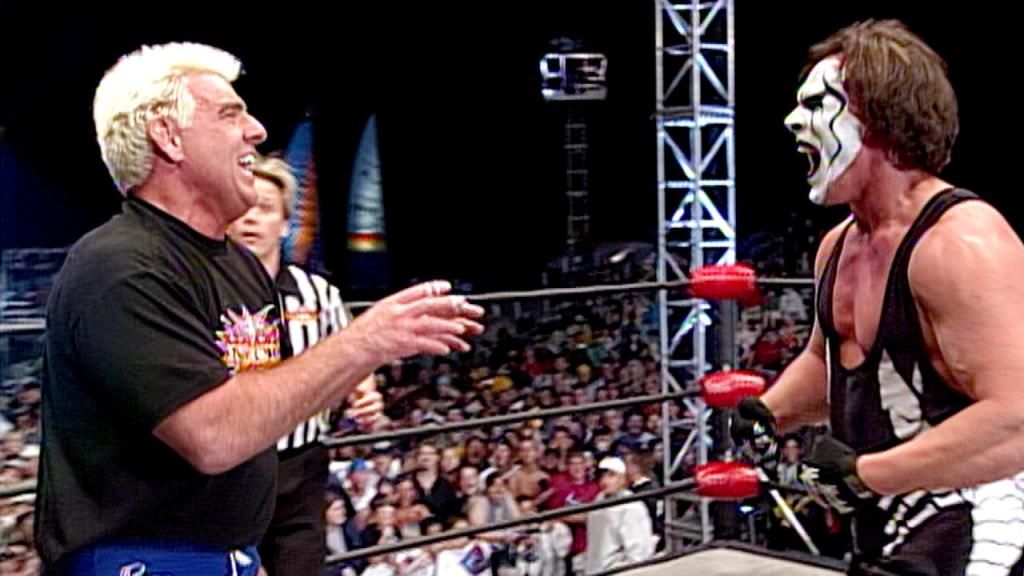
#3. Sting
There’s an argument to be made that Sting vs. Ric Flair should be number one on this countdown. It has many of the trappings of Flair vs. Harley Race in which a veteran champ put over the next generation of main event star, in this case with Flair elevating Sting. It’s a testament to both of the talents and to timing that in this case that Flair not only brought Sting up to his level, but that the two men remained at or adjacent to the main event scene for over a decade. The lines between the NWA, Jim Crockett Promotions, and WCW grow fuzzy at certain points, but if one were to cite the definitive feud of the WCW years—from 1988 to 2001—I’d be hard pressed to accept an argument for any pairing but this one.
The Sting-Flair issue got started in earnest at the very first Clash of the Champoins free TV special, designed to draw viewers away from the WWF’s Wrestlemania 4 PPV. The match went to a forty-five-minute time limit draw—the kind of finish that contemporary fans may be quick to write off as a “non-finish” but for an unproven, musclebound face who wore face paint to go the distance with the most credible wrestler in the world, in front of a national audience made Sting. The Stinger would get his day with the world championship later as he and Flair would trade conquests, and more than once over the years ally with one another under the same banner and to combat bigger threats—only for Flair to inevitably turn on Sting, solidifying Flair’s place as one of history’s greatest conniving heels, and Sting’s place one of wrestling’s most dupe-able faces.
Sting and Flair didn’t engage much after the NWO angle took hold but it’s telling that, on WCW’s last show, after the dust of the NWO had settled and other main event acts had come and gone, Vince McMahon reportedly ordered that the last Nitro (and the lone Nitro under his control) would be main evented by one last Sting-Flair encounter. Sting was past his prime and Flair was pretty badly out of shape (by his standards), and yet the two still managed a passable bout that recalled much of the best of their rivalry of yesteryear and, indeed, the very best of WCW. As a coda to this great rivalry, the two would engage again during Flair’s brief stint in TNA another decade down the road.
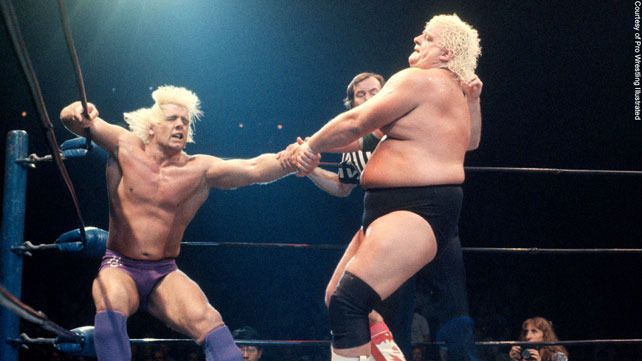
#2. Dusty Rhodes
Ric Flair is among an elite class of legends who, today, transcends heel-face alignment. Whether he uses his skill set for good or evil, he’ll always be The Dirtiest Player in the Game. And we’ll always love him for it.
But before Flair attained such legendary status, he was a heel, period. The limousine riding, jet-flying, kiss-stealing, wheel and dealing son of a gun was the perfect antithesis for Rhodes’s everyman character—the son of a plumber who wore blue jeans and cowboy boots and never had the physique of a playboy or bodybuilder. The two cut wicked promos on one another and engaged in heated battles inside and outside of the ring. Flair’s Four Horsemen were the embodiment of big-time corporations putting Rhodes’s symbolic mom-and-pop operation on the ropes in a series of events that most iconically included the heel stable following Rhodes’s car and brutally pummeling him in a parking lot. Rhodes and Flair would main event back to back Starrcades in 1984 and 1985.
The Rhodes-Flair rivalry benefited from a combination of heat and longevity that few wrestling feuds have ever matched. Indeed, the program had enough fire that WCW dared revisit it a decade and a half later in its very last pay per view show, assembling a combination nostalgia and passing-the-torch tag match in which Flair teamed with pseudo-successor Jeff Jarrett to take on Rhodes and his son Dustin in the semi-main event.
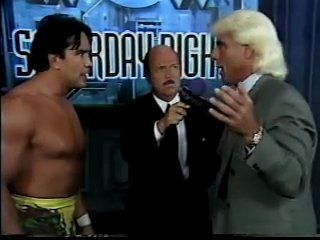
#1. Ricky Steamboat
I had a very difficult time choosing between the top three entries in this countdown, trying to strike a balance between match quality, heat, promo work, longevity, and historical impact of Flair’s top rivalries. Don’t get me wrong, because Flair had great matches with Dusty Rhodes and Sting. But there are great matches and then there are the greatest matches of all time. When you engage in the latter conversation, the Flair-Steamboat rivalry enters truly rarefied air.
Ric Flair and Ricky Steamboat first engaged in the Jim Crockett Promotions days. The rivalry grew personal when Flair ground Steamboats face into the floor backstage to make him less pretty and Steamboat retaliated by ruining one Flair’s fine suits, but, par for the course between the two, the feud defined itself when the two met in the ring for the TV Championship, and Steamboat snagged the pinfall victory.
The period for which this pairing is best remembered, however, came about in 1989 in a trifecta of matches at WCW’s Chi-Town Rumble, a Clash of the Champions special, and WrestleWar. The first encounter saw Steamboat win his one and only world championship. The last saw him drop the strap back to Flair. The general consensus among serious fans is that all three matches were five-star outings, and that each belong in the conversation when you’re talking about the greatest bouts of all time.
In an oft-forgotten revisitation, Flair and Steamboat would rekindle their rivalry over the WCW Championship in the spring of 1994 in a series of matches highlighted by a half-hour double-pin draw in the main event of Spring Stampede.
You can find all kinds of dichotomies in Flair’s great rivalries. He was the wrestler to Vader’s monster; the technician to Hogan’s brawler, the up and comer to Race’s veteran, the player to Savage’s loyal husband, the quintessential heel to Sting’s heroism, and the white collar douche to Rhodes’s everyman. The Flair and Steamboat pairing represented many of these dualities—Flair’s excess to Steamboat’s family man lifestyle, Flair’s predominantly heel act to Steamboat always playing the face—but what may be most important to making this rivalry so special was the commonalities between the two in the ring–the special brands of technical know-how, endurance, and psychology that produced a truly legendary series of matches.
Which of Ric Flair’s rivals would you have added to the countdown? Terry Funk? Lex Luger? Roddy Piper? Triple H? Let us know in the comments section. See you in seven.
Read stories and miscellaneous criticism from Mike Chin at his website and his thoughts on a cappella music at The A Cappella Blog. Follow him on Twitter @miketchin.







